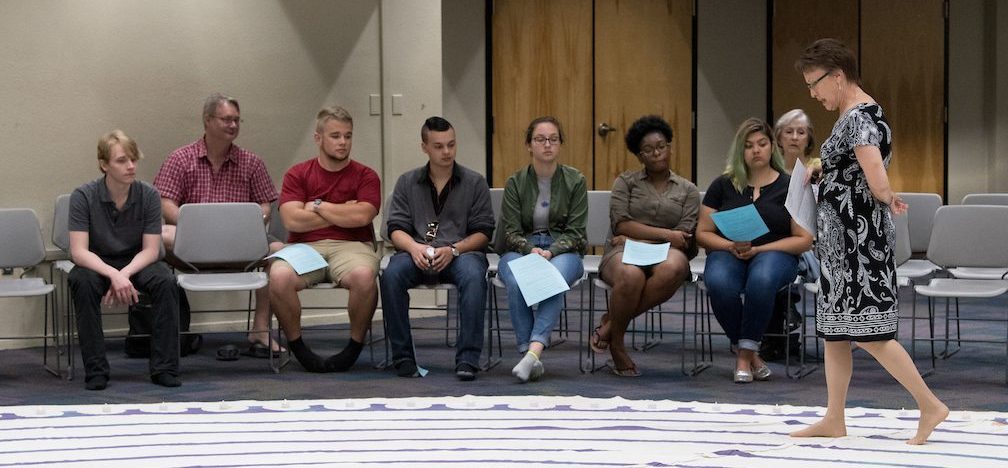Historical Labyrinth Display Provides Opportunity to Meditate
Pensacola – A painted canvas replica of the labyrinth design from the stone floor of the Cathedral of Notre Dame de Chartres was installed in the Commons Auditorium at the University of West Florida from March 27 through 30.

The Chartres labyrinth design symbolizes the pilgrimage to Jerusalem and is based on earlier spiral designs from prehistory. Such labyrinths have been discovered on every continent.
“Completing the labyrinth is a form of meditation,” said Patrick Dickson, a UWF senior. “It’s a good chance for people to focus on nothing more than walking.”
Dickson was one of dozens of volunteer guides to the labyrinth from Dr. Marie-Therese Champagne’s 3000-level history class called “The High Middle Ages.”
“Today many healthcare institutions as well as churches are installing indoor or outdoor labyrinths as tools for personal reflection and meditation,” Champagne said. “It’s a chance to disconnect from the world, and we all need to do that sometimes.”
Students and community members who took a break from their days to walk the labyrinth while it was in the Commons Auditorium experienced an atmosphere similar to that of a Gothic cathedral circa 1200 A.D.
Everyone remained silent. Incense burned, and authentic musical compositions from the period played through speakers.
At four separate times during the installation of the labyrinth, The UWF Chamber Choir, under the direction of Dr. Peter Steenblik, UWF director of choral activities, sang Gregorian chant. They wore authentic habits as they chanted in Latin.
“Doing the labyrinth in this atmosphere was an inspiring and peaceful process,” Cody Sutton, a UWF senior said. Sutton stopped by the Commons Monday morning to walk. “I wasn’t sure what to expect, but with the music in the background you can definitely feel a presence.”
Champagne said that not only is walking the labyrinth a relaxation tool, it’s a chance to put aside 21st century perspectives and understand the concepts of another time.
Having the labyrinth available is an example of high impact learning, Champagne said.
High impact learning is an immersive approach designed to engage students directly with material rather than relying on traditional lectures by the professor.
Champagne has organized the labyrinth project numerous times since 2009.
“People can really get into it and experience it,” Champagne said. “They are walking around in a darkened interior. They are hearing music. They are smelling incense. The only thing we are missing is the kind of stone ceiling that would have been in the cathedral around 1200.”



